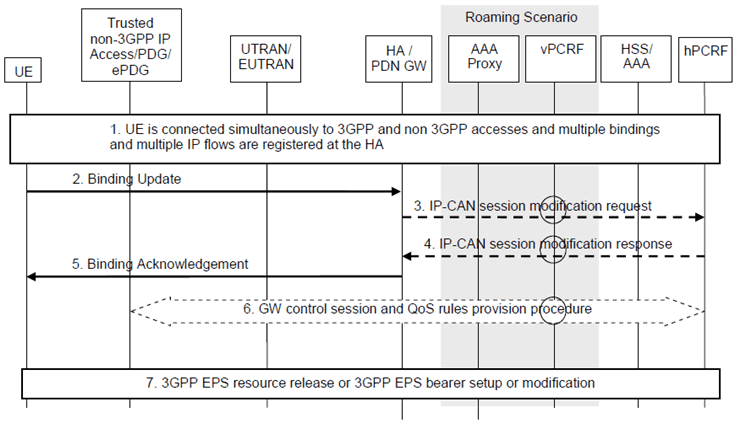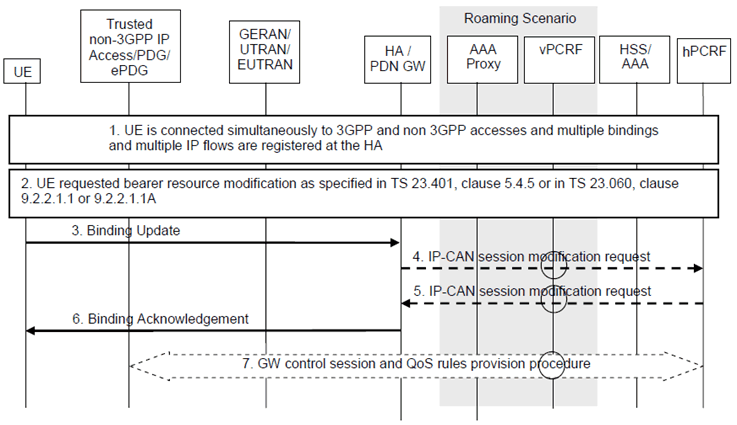Content for TS 23.261 Word version: 18.0.0
5.4 IP flow mobility within a PDN connection
5.4.1 General
5.4.2 IP flow mobility within a PDN connection with network-initiated dynamic PCC
5.4.3 IP flow mobility within a PDN connection with UE-initiated resource request
5.4 IP flow mobility within a PDN connection p. 15
5.4.1 General p. 15
This clause specifies the IP flow mobility procedures within a PDN connection. In these procedures the UE is assumed to simultaneously connect via a 3GPP access and a WLAN access. The UE is using both the accesses for the same PDN connection. Subsequently, the UE adds/modifies/deletes/moves between accesses IP flows using DSMIPv6 messages.
Non-roaming, home routed roaming and Local Breakout cases are supported by this procedure. The AAA proxy and vPCRF shown in Figure 5.4.2-1 are only used in the case of home routed roaming and Local Breakout. In non-roaming scenarios, the AAA proxy and vPCRF are not involved.
The optional interaction steps between the gateways and the PCRF in the procedures only occur if dynamic policy provisioning is deployed in EPC. These steps are not present when the solution is applied to I-WLAN mobility architecture according to TS 23.327.
There are two scenarios, depending on UE initiates the QoS establishment in the target access or the network performs the QoS establishment when the IP flow is moved.
5.4.2 IP flow mobility within a PDN connection with network-initiated dynamic PCC p. 15
In this scenario the UE moves one or more IP flow(s) from one access to the other access and network-intiated dynamic PCC is used is used to set up or remove appropriate resources.

Step 1.
The UE is simultaneously connected to a 3GPP access and a WLAN access based on the procedures specified in clauses 5.2 and 5.3. Based on current routing rules some traffic is routed through the 3GPP access and some other traffic through the WLAN access.
Step 2.
The UE sends a Binding Update (HoA, BID, FID) as specified in RFC 5555, RFC 5648 and RFC 6089 to the HA to install a new routing rule or to modify the routing address of an existing routing rule to route the respective traffic (identified by the included FID) through one particular access (identified by the included BID) or to remove an existing routing rule. In case of new routing rule with a new FID mobility option, the UE includes the routing filter description.
Step 3.
In case the HA function is implemented in EPC, the PDN GW sends an IP-CAN session modification request to the PCRF. In this request the PDN GW provides the updated routing rules to the PCRF. The PCRF stores the updated mapping between routing addresses and SDFs.
Step 4.
If the HA function is implemented in EPC, based on the successful establishment of resources in the WLAN access, the PCRF sends an acknowledgement to the PDN GW, including updated PCC rules if appropriate.
Step 5.
The HA sends a Binding Acknowledgment (Lifetime, HoA, BID, FID) as specified in RFC 5555, RFC 5648 and RFC 6089, to indicate which routing rules requested by the UE are accepted.
The PDN GW/HA may send message 5 before receiving the reply from PCRF in message 4.
Step 6.
If the HA function is implemented in EPC, based on the IP-CAN session modification request, the PCRF ensures that the relevant QoS rules are installed in the target access or the relevant QoS rules are uninstalled from the source access. For non-3GPP access, this is done by a GW control session and QoS rules provision procedure as specified in TS 23.203.
Step 7.
If the HA function is implemented in EPC, appropriate EPS resource release procedures are executed for those resources that were moved away from the 3GPP source access or appropriate EPS resource allocation procedures are executed for those resources that were moved onto the 3GPP access, as specified in TS 23.402. This procedure may be triggered by the PCRF via a GW control session and QoS rules provision procedure if PMIPv6 is used on S5 and it may be triggered by the PDN GW in case GTP is used on S5.
5.4.3 IP flow mobility within a PDN connection with UE-initiated resource request p. 16
In this scenario the UE requests for resources in the target access with UE-initiated procedures and when the resources are provided, the UE moves one or more IP flow(s) to the target access.

Step 1.
The UE is simultaneously connected to a 3GPP access and a WLAN access based on the procedures specified in clauses 5.2 and 5.3. Based on current routing rules some traffic is routed through the 3GPP access and some other traffic through the WLAN access.
Step 2.
Before moving an IP flow currently routed over WLAN to the 3GPP access, the UE requests appropriate resources in the 3GPP access. This is done as specified in clause 5.4.5 of TS 23.401 or in clause 9.2.2.1.1 or 9.2.2.1.1A of TS 23.060. In this procedure the UE includes the packet filters related to the requested resources. In this step if the HA function is implemented in EPC, the PDN GW may interact with the PCRF to trigger the appropriate PCC decision. The PCRF can authorize the resource establishment but since there is no change in the routing rules provided by the PDN GW.
Step 3.
The UE sends a Binding Update (HoA, BID, FID) as specified in RFC 5555, RFC 5648 and RFC 6089 to the HA to install a new routing rule or to modify the routing address of an existing routing rule to route the respective traffic (identified by the included FID) through one particular access (identified by the included BID) or to remove an existing routing rule. In case of new routing rule with a new FID mobility option, the UE includes the routing filter description.
Step 4.
In case the HA function is implemented in EPC, the PDN GW sends an IP-CAN session modification request to the PCRF. In this request the PDN GW provides the updated routing rules to the PCRF. The PCRF stores the updated mapping between routing addresses and SDFs.
Step 5.
If the HA function is implemented in EPC, based on the successful establishment of resources in the WLAN access, the PCRF sends an acknowledgement to the PDN GW, including updated PCC rules if appropriate.
Step 6.
The HA sends a Binding Acknowledgment (Lifetime, HoA, BID, FID) as specified in RFC 5555, RFC 5648 and RFC 6089, to indicate which routing rules requested by the UE are accepted.
The PDN GW may send message 6 before receiving the reply from PCRF in message 5.
Step 7.
If the HA function is implemented in EPC, based on the IP-CAN session modification request, the PCRF ensures that the resources associated with the routing filters moved to the 3GPP access are released. This is done by a GW control session and QoS rules provision procedure as specified in TS 23.203.